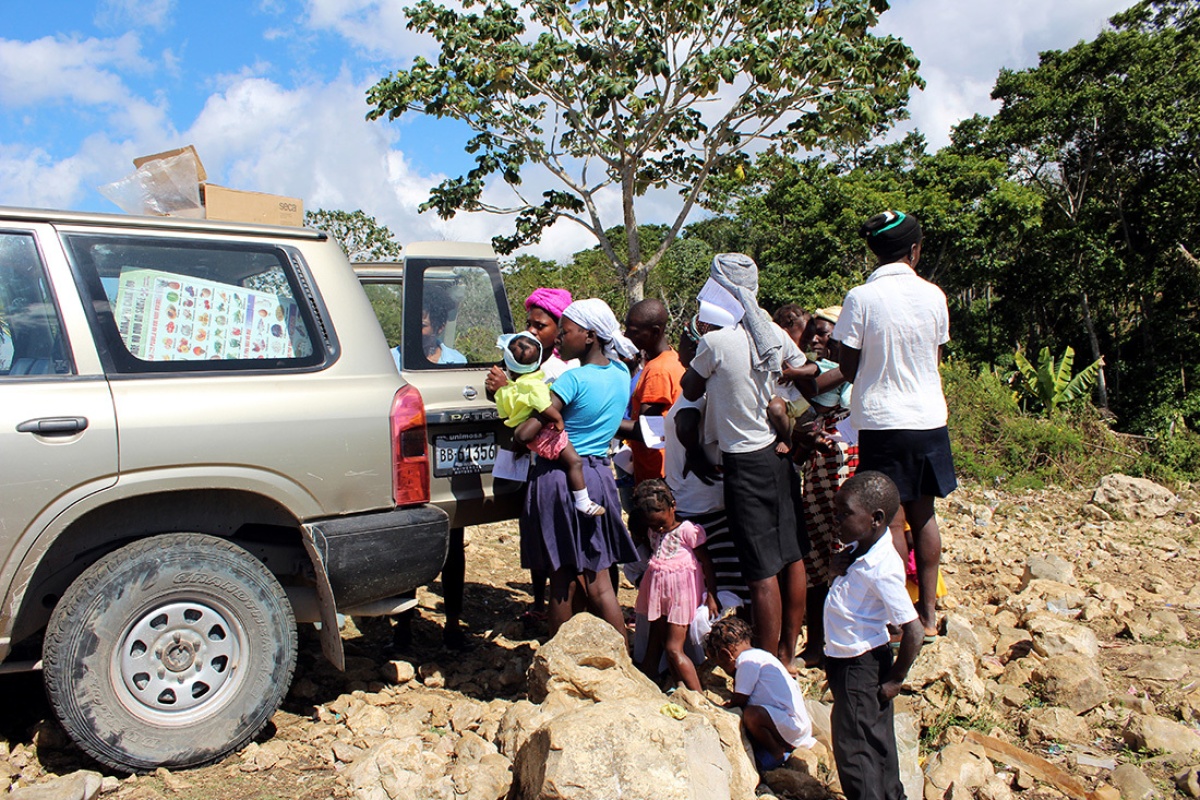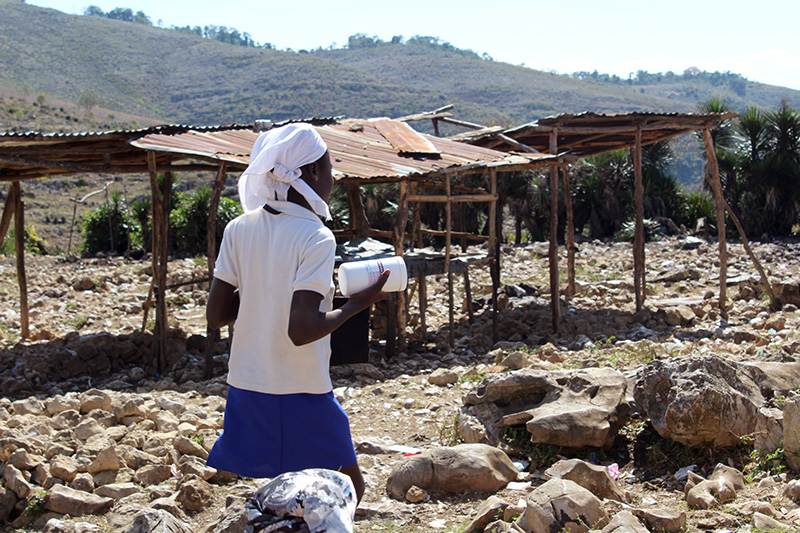Feeding Children to Curb Malnutrition in Haiti
Mobile clinics treat patients sooner, educate families on gender bias and nutrition
Posted on Nov 3, 2023

Philistin Gloria’s parents were worried. Their 2-year-old child, the third of four, was refusing to eat, despite her thin frame, and her breathing had become labored. So Gloria’s father, a driver, and mother, a street vendor in Estere, a village in the Artibonite region, rushed to the hospital with their little girl early last year. Gloria was quickly diagnosed with severe acute malnutrition, as well as tuberculosis and edema. At the time, the child weighed a few ounces over 15 pounds. According to the World Health Organization, the average weight for a 24-month-old girl is 26.5 pounds.
In Haiti, food insecurity has only grown worse in recent years, as violence, gang warfare, and social and political unrest have escalated. With 44% of the population facing major food consumption gaps,the worsening food crisis has left the country with the heaviest burden of hunger and malnutrition in the Western Hemisphere.
Young children are particularly vulnerable. A recent Demographic and Health Survey reported that 22% of Haitian children under 5 were stunted; 4% suffered from moderate to severe wasting; and 10% were underweight. Approximately 1 of every 10 children will die before reaching 5 years old, a trend largely driven by hunger and malnutrition. Even when acute malnutrition is not fatal, the survey notes, it is a major source of human suffering. Partners In Health (PIH) seeks to curb this deadly trend.
A collaboration between PIH Canada and Zanmi Lasante (ZL), as PIH is known in Haiti, deploys mobile food clinics staffed with medical professionals and community health workers (CHWs) to sites in the Artibonite region, seeking to identify malnourished children earlier, so treatment can be delivered before health problems turn fatal. The program focuses on communities with the highest burden of malnutrition in the areas Zanmi Lasante serves, Hinche and St. Marc, and is slowly making progress, not only by decreasing malnutrition but also by eroding some of the entrenched gender stereotypes that undergird child hunger.
For instance, in the year before the mobile clinics were launched, 18 children died of malnutrition at Hôpital Saint-Nicolas in St. Marc. When the mobile clinics began the following year, the fatality rate dropped by 56%, with eight deaths. From April 2022 through March 2023, however, not a single child died of malnutrition in St. Marc.
In addition, a recent report documenting the program’s gains over the past 26 months shows:
- More than 2,250 children were cured of malnutrition;
- Patients visited mobile clinics for malnutrition treatment more than 14,700 times;
- Children were screened over 18,800 times to assess their nutritional status, both in mobile clinics and brick-and-mortar buildings.

Finding Children Under 'Abandonnement'
Katia Bien-Aime, senior nurse and coordinator of Zanmi Lasante's nutrition program, said that years ago, her team noticed a high rate of children who had been seen at the nutrition clinic, but never came back.
“Many were categorized as 'abandonnement,' or lost-to-follow-up at the institutional level,” she said. “We weren’t seeing a lot of kids getting better. We wanted to fix that.”
The mobile clinics allowed providers to get closer to patients, delivering food assistance and other basic medical care to their villages and homes. “It worked,” Bien-Aime said. “We were able to get to the really sick kids faster, earlier, and the lost-to-follow-up rate dropped dramatically.” Indeed, within a year of the mobile clinics being operational, the lost-to-follow-up rate declined by 59%, according to program reports.
In the mobile clinic van, there are nurses and lab technicians who help with HIV and other testing; drivers who navigate often difficult terrain, and CHWs, who know the families in the area and help mobilize parents to secure care for their kids. Sometimes, CHWs go door-to-door as part of their work, or they travel through communities with a megaphone urging people toward the medical vans.
The focus is on nutrition, Bien-Aime said, but often, acute hunger makes children susceptible to other illnesses. So, the mobile units also provide tools to clean water and improve sanitation and hygiene, as well as offering vaccinations for children and education and care for HIV and other opportunistic infections.
“It is possible to fight against this scourge that is malnutrition in the communes of Hinche and Saint Marc,” said Dr. Alain Gelin, a Zanmi Lasante project manager. “The mobile clinics are particularly effective at preventing severe forms of malnutrition. … As the clinics ramped up, fewer children required inpatient care, as their malnutrition was being detected earlier.”
Gender Bias Remains
Over time, Bien-Aime said she and her colleagues observed how gender considerations play out in the ways children are fed. For instance, she said: “There’s a myth that little boys eat more than little girls.” Many people believe that boys will be stronger, more robust, and bigger than girls, and therefore need more time breastfeeding and more food in general.
“If there are twins, you will see it really clearly,” she added. “The boy twin will be bigger than the girl; resources are divided in that way.”
These biases can be dangerous on many levels. Clinicians categorize hunger by severity, ranging from moderate to severe and, finally, severe with medical complications. Through gender analyses conducted by the PIH and Zanmi Lasante teams, it appears that girls are disproportionately affected by hunger in all but its most acute form and generally treated as outpatients. This means that more boys, who suffer from the most extreme and dangerous forms of malnutrition, most often require inpatient care. In the last year, that has meant more boys died. The hypothesis is that all of these long-held beliefs about boys being more robust affect the timing of when parents bring children in for treatment. They think boys are stronger, so they delay seeking health care for their sons. The results: at all of the sites tracked, there were five total deaths, one was female, and four were male.
Another way gender impacts malnutrition relates to the demands of feeding families, which largely fall on women.
“Feeding children and meal preparation put demands on women’s time,” Bien-Aime said. “But if she is busy, or must go to the market, or work on the harvest, food doesn’t get made and feeding is delayed.”
So is medical care. Often the reason a child is lost-to-follow-up is because the mother didn’t have time to bring the child in. “It’s mainly women who bring the kids in [to the clinic],” Bien-Aime said. “Mothers, grandmothers, sisters and, rarely, a dad, brings them in.”
Addressing Gender Stereotypes and Malnutrition
Training on gender is central for care providers—even the mobile clinic drivers—supporting families with malnutrition, Bien-Aime said. The messaging is integrated into education sessions and treatment delivery, for instance, telling mothers that, “Each kid is unique, and there should not be a difference in how food is distributed in the household," she said. "We focus on how parents can be engaged; talk about how dads can be involved in feeding, health, and recovery. Treatment is given based on weight, and follow-up care is based on recovery.”
For 27-month-old Tinonm Carlens from Rivage, the mobile clinics were key. Raised in a single-parent family, Carlens’s mother, Saint Jean Milove, a shopkeeper, played the roles of both mother and father in caring for her child. Carlens was growing thinner and his health was deteriorating, but his mother found it quite difficult to walk to the hospital and back. But the team from the mobile clinic diagnosed the child with severe acute malnutrition with medical complications earlier this year. He had a cough, fever, brittle hair, and weighed 15.8 pounds. He was admitted to the Hospital St. Therese in Hinche’s nutritional stabilization unit for treatment.
After 22 days, he was sent home, while continuing treatment at the mobile clinics. After six follow-up appointments, the child had stabilized with a weight of just over 23 pounds.
Navigating Enormous Challenges
These days, it’s become more difficult to navigate the mobile clinics into communities, with gangs blocking roadways and violence preventing access to towns. The security disruptions were particularly challenging around St. Marc, where getting out of the city center is often difficult and dangerous with gangs controlling the area.
Still, for the most part, the nutrition teams have been able to provide care to people where they live, whether that means rescheduling clinic visits or finding an alternative route.
“The mobile clinic team delivered services in the face of enormous challenges, from gas shortages and vehicle issues to gang activity, kidnappings and the personal mental toll,” Gelin said. “These results are a testament to their commitment and resolve.”

